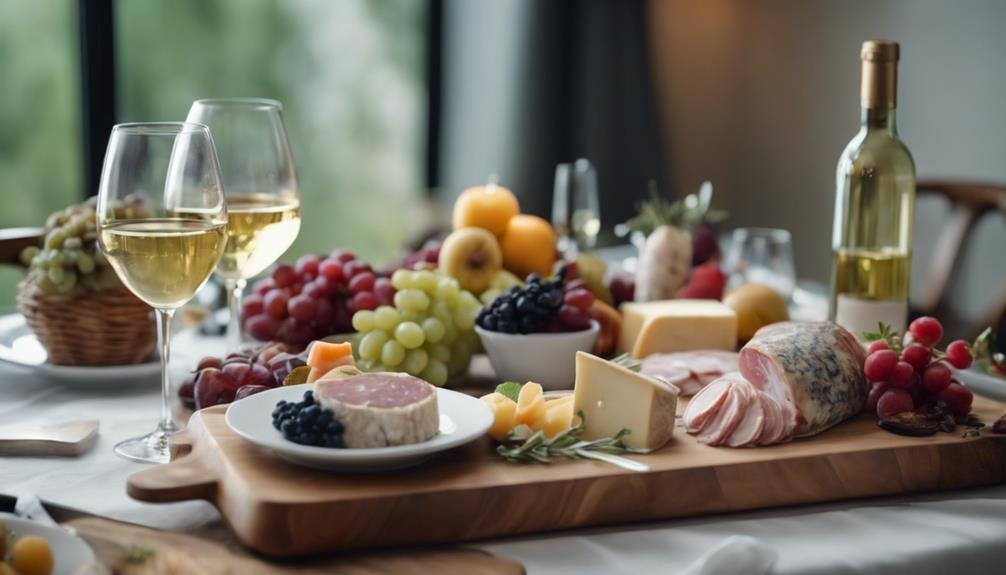Begin a journey through aromatic white wines, like Albariño with lime blossom notes or Gewürztraminer's lychee essence. Ideal serving at the right temperature enhances your tasting adventure. Pair Gewürztraminer with coconut-infused dishes or savor with light meats and seafood for a delectable experience. Explore the science behind these wines – terpenes like linalool create floral scents, shaping their unique profiles. Wine expert Madeline Puckette shares her knowledge on evolving wine trends, sensory analysis, and terpene impacts. Discover this enchanting world of aromatic whites, each sip a gateway to a universe of delightful flavors and aromas that await exploration.
Aromatic White Wine Varieties
Aromatic white wine varieties encompass a diverse range of flavors and aromas, including lime blossom, jasmine, lychee, orange blossom, and more.
Exploring flavor profiles reveals Albariño with lime blossom and lemon, Riesling with jasmine and green apple, Gewürztraminer with lychee and pink grapefruit, Vidal Blanc with jasmine and pineapple, and Muscat Blanc with orange blossom and Meyer lemon.
Regional comparisons showcase unique characteristics, such as Albariño and Loureiro from Spain featuring grapefruit and melon notes, while Gewürztraminer from Alsace, France, offers lychee and rose flavors.
Understanding these distinctions allows wine enthusiasts to appreciate the complexity and variety within the world of aromatic white wines.
Serving Tips for Aromatic Whites
When serving aromatic white wines, it is important to take into account the optimal temperature and glassware to enhance the overall tasting experience. Chilling techniques play a significant role in improving these wines. It is recommended to serve aromatic whites chilled in a white wine glass to preserve their delicate aromas and flavors.
Higher quality wines can be served slightly warmer to allow for better expression of their unique characteristics. Some enthusiasts prefer wider bowl glasses to enhance aroma collection, intensifying the tasting experience. By paying attention to these details, you can fully appreciate the nuances of aromatic white wines.
Mastering the art of serving these wines will certainly enrich your enjoyment of their invigorating and aromatic profiles.
Food Pairing Suggestions

Exploring the culinary synergy between aromatic white wines and various dishes enhances the overall dining experience, elevating flavors and creating harmonious pairings. When considering food pairings with aromatic white wines, here are some flavorful suggestions for a delightful culinary experience:
- Flavorful pairings: Enhance the taste of coconut-infused dishes with Gewürztraminer for a delightful tropical fusion.
- Culinary inspiration: Incorporate aromatic white wines as ingredients or accompaniments in your cooking to elevate flavors and create unique dishes.
- Pairing suggestions: Aromatic whites complement aromatic Southeast Asian and Indian cuisine excellently, making them perfect companions for lighter meats, poultry, or seafood dishes.
These suggestions offer a starting point for discovering the perfect pairing to enhance your dining experience with aromatic white wines.
The Science of Aromatic Whites
The distinct aromatic profiles of white wines are intricately tied to the presence of specific compounds like terpenes, particularly monoterpenes such as linalool, which contribute to their floral notes and unique sensory characteristics. Aromatic white wines, known for their alluring scents, contain higher levels of terpenes, with monoterpenes playing a significant role in imparting floral aromas. These compounds are synthesized within grapevine cultivars, influencing the overall flavor profile of the wine. Understanding the science behind these terpenes enhances appreciation for the complexity of aromatic whites. Below is a brief overview of the key elements involved in the terpene synthesis process:
| Terpene Synthesis | Grapevine Cultivars | Monoterpenes |
|---|---|---|
| Responsible for the production of terpenes in plants | Varieties of grapevines that produce terpene-rich wines | Key compounds contributing to floral aromas in white wines |
Notable Wine Expert: Madeline Puckette

Renowned in the wine industry, Madeline Puckette is a distinguished expert known for her exceptional contributions to wine education and communication.
3 Notable Facts about Madeline Puckette:
- Wine Trends: Puckette stays up-to-date with the latest wine trends, offering valuable insights into evolving consumer preferences.
- Sensory Analysis: Known for her expertise in sensory analysis, Puckette guides enthusiasts in understanding the nuances of wine flavors and aromas.
- Terpene Profiles: Puckette explores terpene profiles, helping enthusiasts appreciate the impact of these compounds on wine's aromatic characteristics.
Through her work, Madeline Puckette continues to shape the wine industry, making it more accessible and intriguing for wine enthusiasts worldwide.
Frequently Asked Questions
Can Aromatic White Wines Be Aged Like Red Wines?
Aromatic white wines generally lack aging potential like red wines due to lower tannin and acidity levels. While some may benefit from short-term cellaring for development, it's advisable to enjoy them young to savor their fresh, vibrant aromas.
Are There Any Health Benefits Associated With Drinking Aromatic White Wines?
Wine antioxidants in aromatic white wines offer potential health benefits. Aromatic wine benefits may include antioxidant properties linked to heart health and reduced inflammation. Enjoying these wines in moderation can be a flavorful way to potentially boost health.
Do Aromatic White Wines Pair Well With Spicy Foods?
Aromatic white wines, with their floral and fruity flavor profiles, complement spicy foods by providing a cooling contrast to the heat. The aromatic nature of these wines enhances the dining experience by balancing the spiciness with their own unique characteristics and heat resistance.
How Do Terpenes in Aromatic White Wines Affect the Flavor?
Terpenes impact aromatic white wines by contributing to their distinctive flavor profiles. These organic compounds, particularly monoterpenes like linalool, are responsible for floral aromas. Understanding terpenes enhances appreciation of the nuanced flavors in these wines.
Can Aromatic White Wines Be Used for Cooking as Well as Drinking?
Aromatic white wines can elevate dishes with their intense flavors. Their versatile nature makes them ideal for cooking, enriching dishes like coconut-infused cuisine. They boast exquisite flavor profiles, enhancing meals and offering a sophisticated culinary experience.
Conclusion
In the domain of aromatic white wines, a symphony of scents and flavors awaits, enchanting both the senses and the soul. Through the delicate dance of terpenes and aromas, these wines offer a truly mesmerizing experience for all who partake.
As we delve into the mysteries and complexities of these aromatic whites, we set out on a journey of exploration, revealing a world of sensory delights that go beyond mere taste.
Join us in savoring the magic of these wines, where each sip tells a tale of elegance and allure.